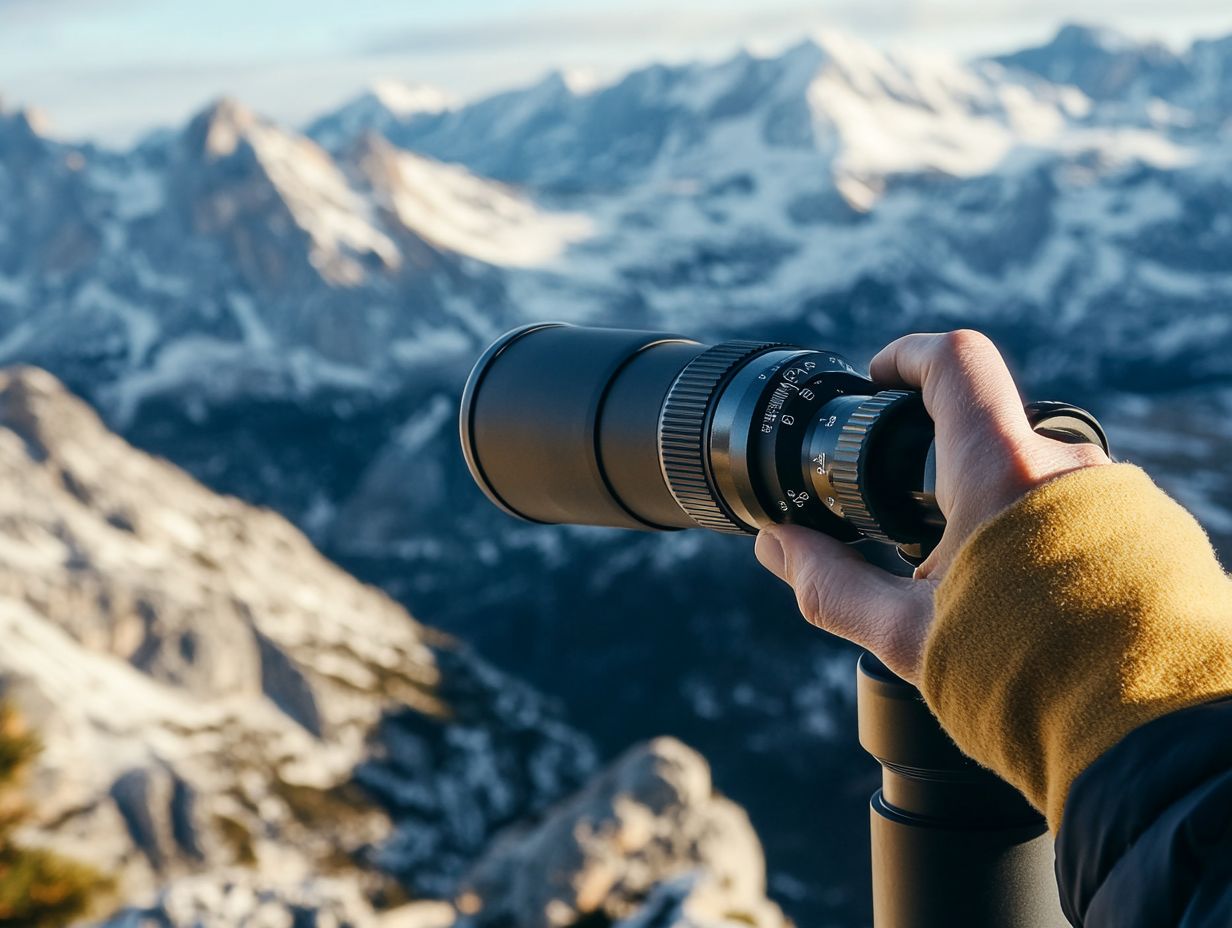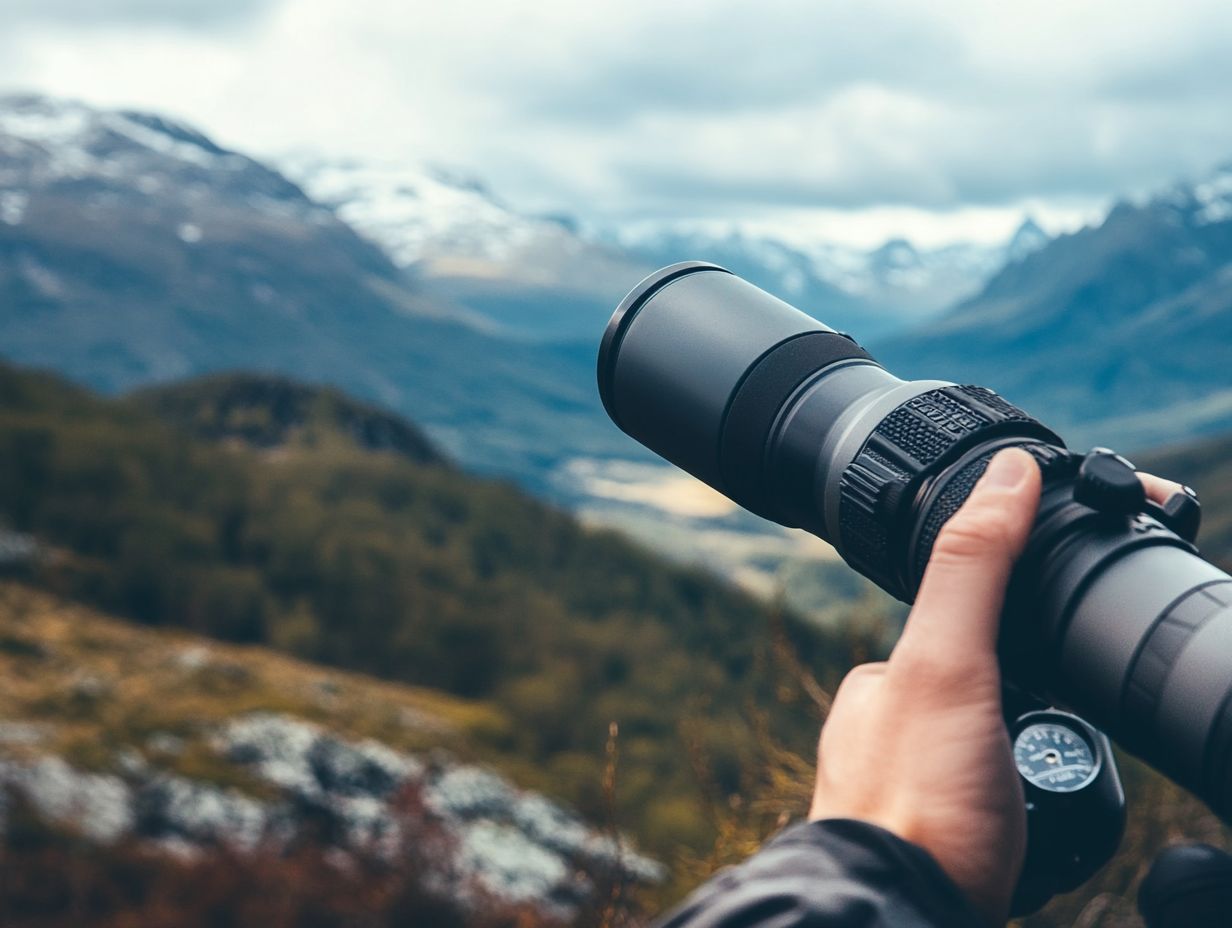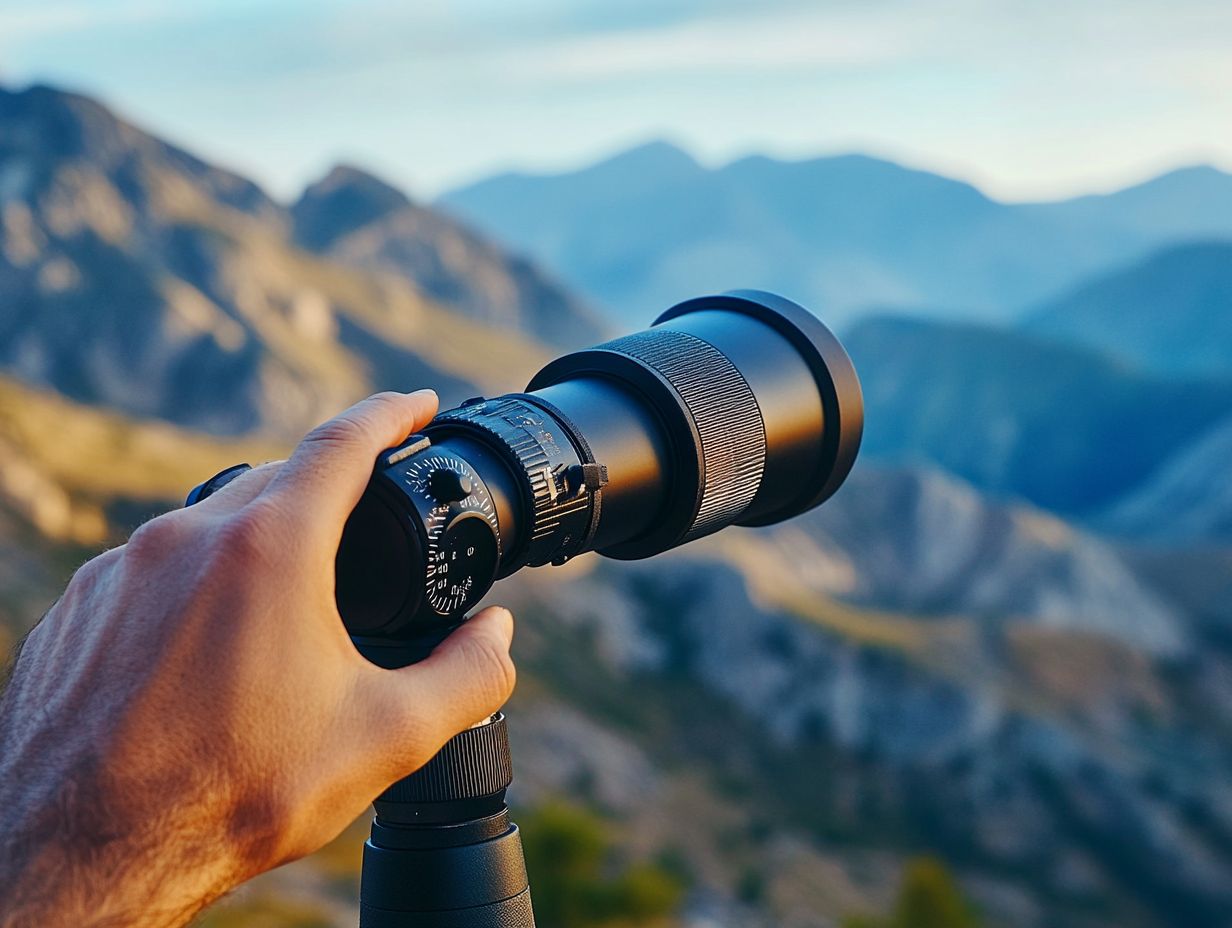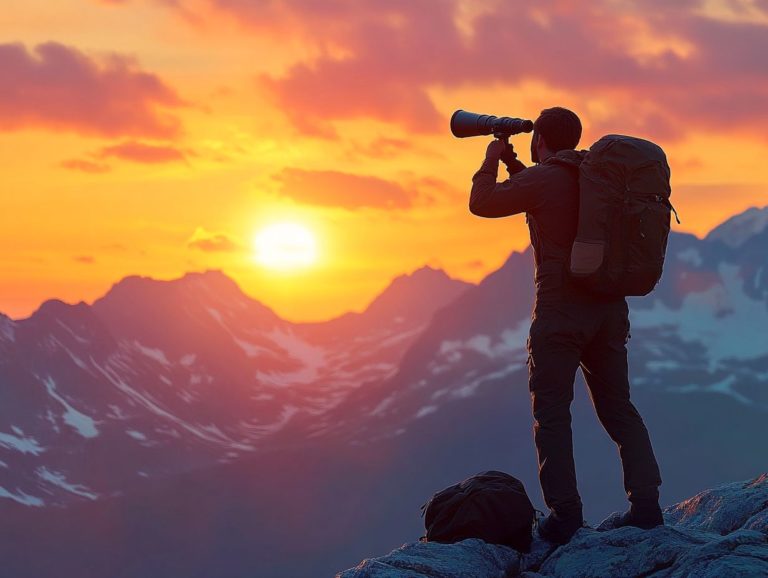The Importance of Magnification in Spotting Scopes
Understanding magnification in spotting scopes is essential for outdoor enthusiasts like you. It greatly affects your performance in various conditions.
Choosing a spotting scope, especially from the Vortex lineup, means investing in high magnification and advanced optical technology. This is crucial for tracking targets and observing wildlife like the majestic White-tailed Eagle.
Effective light gathering and the quality of extra-low dispersion or high-definition glass enhance your overall visibility.
Contents
- Key Takeaways:
- Understanding Magnification in Spotting Scopes
- Benefits of Higher Magnification
- Factors Affecting Magnification
- Choosing the Right Magnification for Your Needs
- Using Magnification Effectively
- Frequently Asked Questions
- What is magnification and why is it important in spotting scopes?
- How is magnification measured in spotting scopes?
- Does higher magnification always mean better image quality?
- What is the ideal magnification for different activities when using a spotting scope?
- Can I change the magnification of a spotting scope?
- How does magnification affect the price of a spotting scope?
Key Takeaways:

- Magnification in spotting scopes increases clarity and allows you to see distant objects.
- The quality of magnification is influenced by factors like optical design and environmental conditions.
- When choosing a spotting scope, consider your specific needs and activities to determine the right level of magnification.
Understanding Magnification in Spotting Scopes
Magnification in a spotting scope enlarges distant objects, revealing details that would otherwise remain hidden from your naked eye, thanks to understanding the technology behind spotting scopes.
This impressive feat is achieved through a sophisticated blend of high-quality lenses and cutting-edge optical technology, designed to enhance the clarity of the images you observe. Spotting scopes often feature variable zoom capabilities, enabling you to adjust the magnification level based on your preferences or conditions.
For example, renowned brand Swarovski offers models with versatile zoom ranges that let you switch seamlessly between lower magnifications for wide-field viewing and higher magnifications for intricate observations. This flexibility makes their scopes perfect for everything from casual strolls in nature to serious wildlife photography.
Benefits of Higher Magnification
Opting for higher magnification in spotting scopes unlocks significant advantages, especially in backcountry hunting and wildlife observation. For a deeper dive into what to look for, understanding spotting scope specifications will enhance clarity and detail, elevating your viewing experience and allowing you to engage with nature more profoundly.
Improved Clarity and Detail
One standout advantage of higher magnification is the remarkable boost in clarity and detail you ll experience. You can spot intricate features in wildlife and landscapes like never before.
This enhancement shines particularly bright in models like the Vortex Razor HD and the Swarovski ATS, which utilize advanced HD glass to deliver crisp, clear images over impressive distances.
As you increase magnification, you ll be captivated by the delicate characteristics of various species, from the vibrant plumage of a Scarlet Macaw to the intricate fur patterns of a snow leopard. This level of detail not only enhances your viewing experience but also supports accurate identification and deep appreciation of nature’s wonders, transforming each observation into an immersive journey.
Explore your options today and elevate your outdoor experience!
Ability to Spot Distant Objects

The ability to spot distant objects is a remarkable advantage of using a high-magnification spotting scope. This essential tool empowers you as a backcountry hunter to track targets across vast landscapes. It goes beyond mere observation; it gives you the power to assess the terrain and the behavior of your quarry from a safe distance.
For wildlife observers like you especially birdwatchers this feature opens a world of opportunities. It enables you to identify species that might otherwise remain hidden in thick foliage or far-off treetops. Picture yourself perched quietly atop a ridge, with the scope revealing a herd of elk grazing miles away, providing crucial insights into their movement patterns.
As a birdwatcher, you can effortlessly spot a rare bird soaring high in the sky, documenting its unique features without disturbing its natural habitat. Such scenarios illustrate how high magnification transforms your outdoor experiences, making it invaluable for enhancing both your skills and enjoyment in your pursuits.
Factors Affecting Magnification
Let’s explore the exciting factors that boost your spotting scope’s effectiveness. Several elements will influence the effectiveness of magnification in your spotting scopes.
Consider the optical quality and design of the scope. These elements play a crucial role in performance.
Environmental conditions significantly affect image clarity and overall usability, so keep that in mind when selecting your equipment.
Optical Quality and Design
The scope’s optical quality and design are crucial for achieving optimal magnification, as they directly influence the clarity and brightness of the images you ll see.
Investing in premium optics ensures that you can fully leverage your spotting scope in a variety of conditions, whether you are an outdoor enthusiast or a professional user. Factors like lens coatings special layers on the lenses that reduce glare are essential. They enhance light transmission, ultimately providing you with a more vivid visual experience.
Regarding glass materials, options like Extra Low Dispersion (ED) glass, which reduces color distortion, and High Definition (HD) glass, which provides high clarity, can significantly enhance color accuracy and detail resolution.
Brands such as Vortex and Zeiss exemplify these advancements with their innovative designs and meticulous craftsmanship, resulting in spotting scopes that deliver exceptional performance. With these tools at your disposal, you can truly appreciate the finer details in distant subjects.
Environmental Conditions
Environmental conditions, such as light levels and atmospheric clarity, have a profound impact on the performance of your spotting scope. These factors influence its light-gathering capabilities and overall image quality in various hunting scenarios.
As you venture into the backcountry, you ll likely face environmental challenges from dense fog to blinding sunlight that can distort visibility and compromise your scope’s efficiency. Temperature fluctuations and humidity also play a role, affecting air density and making it trickier to spot distant game.
When the light wanes, the scope’s ability to gather and transmit light becomes essential. It s important to note that not all scopes excel in these conditions.
Thus, understanding how these diverse factors affect your optics is vital for any serious hunter seeking to enhance their field experience and boost their odds of a successful outing.
Choosing the Right Magnification for Your Needs
Choosing the right magnification for your spotting scope is crucial to enhancing your experience, whether you’re deep in backcountry hunting or observing wildlife. For more insights on this topic, check out the top features to look for in a spotting scope. Different scenarios call for varying levels of detail and distance recognition, so it’s important to match your magnification to your specific needs.
Considerations for Different Activities

When selecting a spotting scope, your choices hinge on whether you’re focused on wildlife watching or hunting. Each activity demands different magnification levels and features for peak performance.
If wildlife watching is your passion, you ll appreciate a scope with a lower magnification range, typically between 20x and 60x. This range offers a wider field of view and stable images. It allows you to catch elusive animal movements in their natural habitat.
You’ll want a scope with a durable, weather-resistant body and high-quality glass. These features deliver brightness and clarity, which are essential.
If hunting is your preference, you ll need a scope with higher magnification, often exceeding 60x, to spot game from greater distances. Here, good stabilization and advanced zoom capabilities are crucial.
For both pursuits, consider models like the Vortex Razor HD or the Leupold SX-5 Santiam for wildlife viewing. If you seek precision and reliability as a hunter, check out options such as the Nikon Prostaff 5 or the Swarovski ATS.
Using Magnification Effectively
Effectively utilizing magnification in spotting scopes involves more than adjusting zoom levels. It also requires understanding proper maintenance techniques and using accessories, like a tripod mount, to ensure stability.
Tips for Adjusting and Maintaining Magnification
To achieve optimal image quality with your spotting scope, it’s crucial to adjust the magnification effectively. Keeping your equipment in excellent condition also ensures both longevity and peak performance.
When adjusting magnification, begin with a lower setting to locate your subject. Gradually increase it for finer details that make all the difference.
Regular cleaning is essential. Use a soft lens cloth to gently remove dust and smudges. A cleaning solution specifically formulated for optics is recommended. Storing your spotting scope in a protective case will safeguard it from damage when not in use.
Don t overlook the benefits of using accessories like a sturdy tripod. This minimizes vibrations, providing a steadier image and making long observation periods more comfortable.
Frequently Asked Questions
What is magnification and why is it important in spotting scopes?
Magnification makes distant objects look bigger, which is important for spotting scopes as it helps you see details you wouldn’t otherwise notice. For a deeper insight, check out the understanding field of view in spotting scopes.
How is magnification measured in spotting scopes?

Magnification is measured as a ratio. The first number represents the size of the object when viewed through the scope, and the second number shows the object’s actual size. For example, a spotting scope with 20x magnification makes an object appear 20 times larger than it is.
Does higher magnification always mean better image quality?
Not necessarily. Other factors also matter, like lens quality and lighting. It s important to find that sweet spot for optimal viewing.
What is the ideal magnification for different activities when using a spotting scope?
The ideal magnification varies by activity. For birdwatching, a magnification of 8-10x is recommended for a wider field of view. For hunting or target shooting, a magnification of 15-20x is ideal for precise, detailed viewing. For stargazing, a higher magnification of 30x or more is needed to see celestial objects clearly.
What questions do you have about spotting scopes? Let us know!
Can I change the magnification of a spotting scope?
Yes! Most spotting scopes let you adjust the magnification easily with a dial or ring. Some also offer different types of lenses for varying levels of magnification.
How does magnification affect the price of a spotting scope?
Generally, spotting scopes with higher magnification cost more. This is due to the complexity of their lenses. Other factors like brand, quality, and extra features also influence the price.






